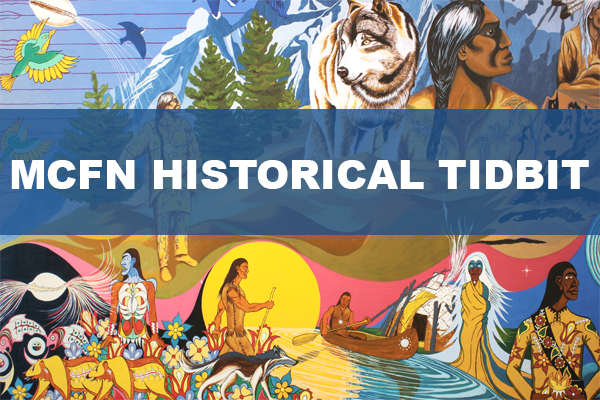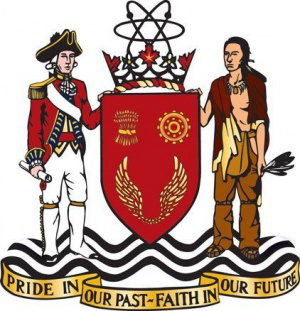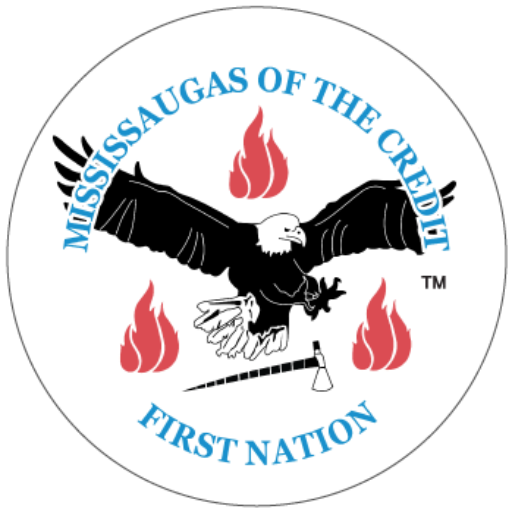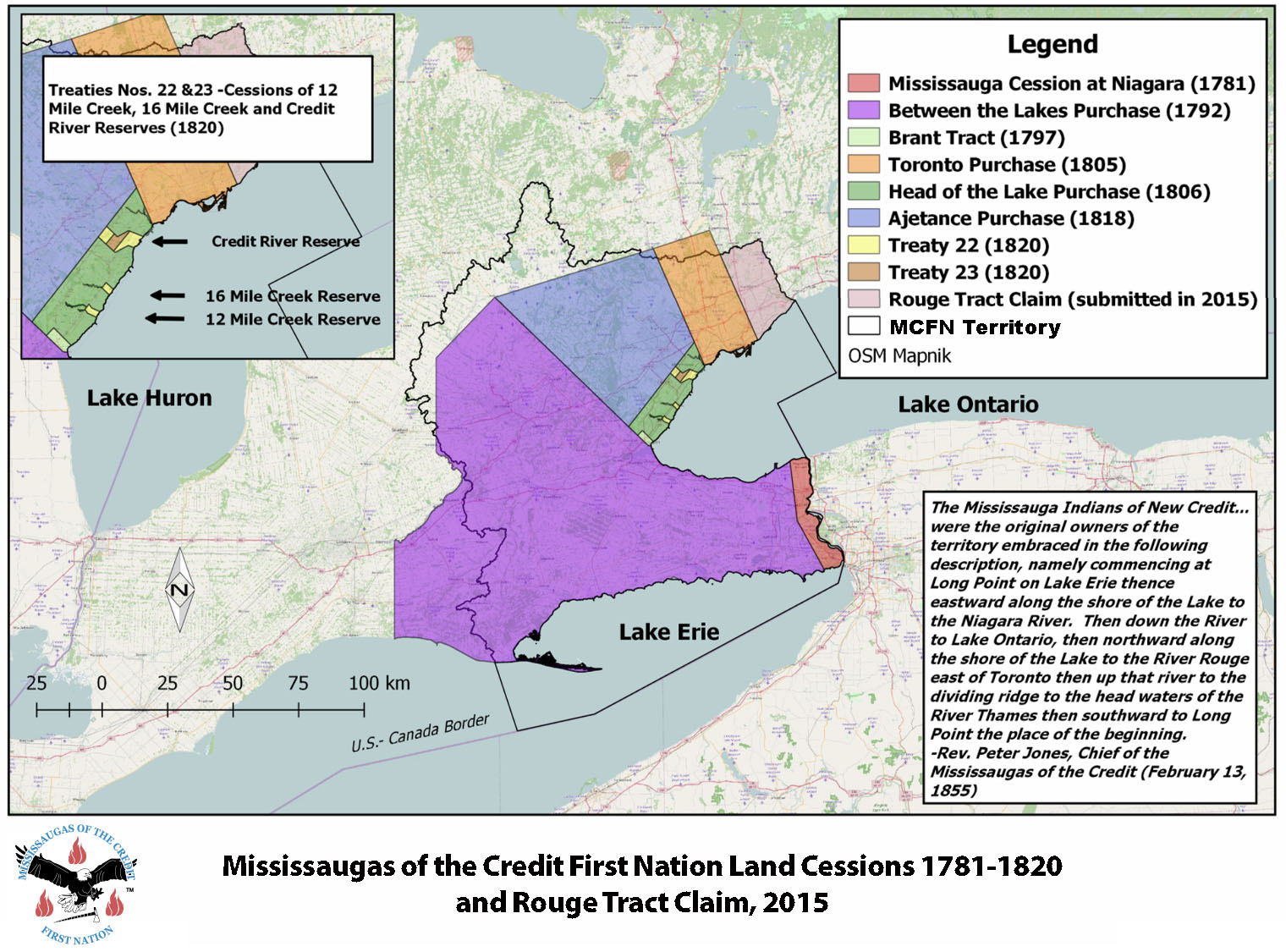Historical Tidbit: The City of Mississauga, Origin of Name and Coat of Arms
Posted on July 27, 2020

by Darin Wybenga, New Credit Public Library
August 2020
The Township of Toronto was facing a problem, not a difficult problem, but a problem that would nevertheless occupy its citizens’ time for several years until its resolution. In 1965, the Township made plans to incorporate as a town and, within a decade, as a city. One of the problems arising out of the plan was the determination of a name for the new town. The “Toronto” moniker, already having been taken by the neighbouring community to the east, the township council asked its residents, in January of 1965, to submit potential names for the town. 2793 individuals sent in their suggestions with 889 different names proposed. Some of the names proposed; such as “Winston”, were meant to honour individuals such as Winston Churchill, the British Prime Minister; other names commemorated villages within the township such as “Port Credit” or “Dixie”. Even “Five and Ten” was proposed as a name, but one name was suggested far more than any other- that of “Mississauga”.
Hugely popular with the public, the name “Mississauga” made up nearly one-fifth of the suggestions submitted for the new name. No one is quite sure why the name resonated with the people of the township although it was generally agreed that the named harkened back to the times when the ancestors of the Mississaugas of the Credit inhabited the area. The Mississaugas left their homes at the Credit River in 1847 for their current location, yet despite their absence, their name was perpetuated in the area by the Mississauga Golf and Country Club; a militia unit known as the 9th Mississauga Horse Regiment; and businesses that incorporated “Mississauga” as part of their firm’s name, for example, Mississauga Motors Limited. The name “Mississauga”, like all the other names submitted, would be screened through a naming committee and the township council until the choice was narrowed down to two possibilities. Although popular with the township populace, “Mississauga” was not so popular with the township council. One councillor acidly remarked: “the Indian tribe of that name which had lived in the area has contributed least to it.”
Sadly, even though “Mississauga” was a popular choice, it seemed as though people had forgotten, or perhaps never knew, that that it was Mississaugas of the Credit ancestors that negotiated the treaty that allowed the township to be settled. On August 2, 1805, the British Crown negotiated with the Mississaugas to acquire 70,784 acres of land in a strip of land six miles deep from the Lake Ontario shoreline and stretching between the western boundary of the Toronto Purchase lands and the western boundary of the Brant Tract lands. Chief Quinipeno, the spokesperson for the Mississaugas at the negotiations, spoke of the reluctance of the people to part with their lands, “…It is hard for us to give away more land: The young men and women have found fault with so much having been sold before; it is true we are poor, the women say we will be worse, if we part with any more,…” The Mississaugas received £1000 in trade goods and the sole right of fishing at 12 and 16 Mile Creeks and the Credit River with land on their flats. The agreement between the Mississaugas and Crown was ratified as the Head of the Lake Treaty, No. 14 in 1806. The Mississaugas had contributed much to the establishment of the future town and city.
On December 9, 1967, the electorate of Toronto Township went to the polls to select a town council and name for the town that would be newly born on January 1, 1968. Voters could choose between “Mississauga” and “Sheridan” for the name of their community. As it turned out, “Mississauga” was the peoples’ choice with 11, 796 votes to 4,311.
The birth of the new town was celebrated at a Midnight ceremony on January 1, 1868. Robert Speck, the first mayor of the Town of Mississauga, and a crowd of 500 citizens enjoyed fireworks and speeches to mark the occasion. Among the crowd that night was Chief Fred King of the Mississaugas of the Credit First Nation. Chief King took the opportunity to remind the good people that the Town of Mississauga was built on lands acquired from his people many years earlier. The Chief, on behalf of the First Nation, presented a medicine stick as a token of good luck to Mayor Speck; in return, Speck presented King with a scroll and a gold key to the Town. While the scroll and the gold key have long since disappeared, another symbol of friendship between the Town of Mississauga and the First Nation has been on display at the New Credit Public Library for years. On July 20, 1968, the Mayor and Council of the Town of Mississauga presented a scroll granting the “Honorary Freedom of the Town” to the Council and Members of the “Mississaugas of the New Credit Reserve” and was ”evidence of the desire by the town to develop a bond of affection and regard with the descendants of the Indian inhabitants of this area, from whence the name originated.”

In 1974, the Town of Mississauga was reincorporated as a city and adopted a coat of arms in which the MCFN’s contribution to the history of the city is called to mind. On one side of the coat of arms is a British Officer holding the Between the Lakes Treaty, and on the opposite side, stands a dignified First Nation’s man, presumably a Mississauga of the Credit member, holding four quill pens each representing one of the Mississauga Chiefs who signed the agreement.
It is hoped when citizens of the city of Mississauga look upon their community’s coat of arms, or hear the name of their city spoken, they are drawn to think of the Mississaugas of the Credit First Nation and the treaty they signed that enabled the birth of a township, a town, and a city.
Thanks to Matthew Wilkinson of Heritage Mississauga and Erma Ferrell for providing the newspaper clippings and the article series, “How Mississauga Got Its Name” by Richard Collins.

